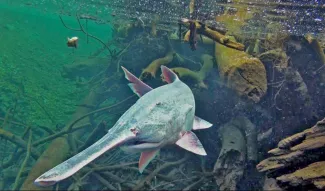
The state's Paddlefish Research Center (PRC) in northeastern Oklahoma will open Wednesday, March 1, for the spring snagging season. Successful anglers are encouraged to donate their paddlefish to the center for biological research, and they won't have to bother cleaning their own catch.
"Our folks here at the Paddlefish Research Center do the cleaning and filleting for them," said Brandon Brown, paddlefish/caviar coordinator for the Oklahoma Department of Wildlife Conservation. "All the anglers have to do is pick up their packaged fillets and enjoy them on the dinner table."
Anglers snagging from the bank or from a boat on Grand Lake or at Miami's Riverview City Park may call the PRC at (918) 542-9422 to ask a staff member to pick up their fish. Anglers will receive a bar-coded key tag to present at the PRC when retrieving their fillets.
Paddlefish must be alive when picked up or brought to the center, which is four miles north of Twin Bridges State Park on State Highway 137.
Seasonal employees at the PRC are trained in the proper handling and processing of fish products. The PRC's specialized processing equipment minimizes waste while removing undesirable red meat. Fillets are then packaged in heat-sealed plastic bags and stored at 34 degrees until they are picked up by the angler within 24 hours.
Also, anglers who have their paddlefish processed at the PRC can rely on Wildlife Department staff to handle the required online reporting of their harvest using online E-Check system.
Hours of operation for the PRC at 9 a.m. to 6 p.m. every day except Mondays and Fridays, through April 30.
Since opening in 2008, the PRC has processed and gathered data on more than 32,000 paddlefish. In the 30 years before 2008, the Department had only managed to collect biological data from just 240 paddlefish.
"What makes this a win-win for both the anglers and the Department is that we are able to collect important biological data on the paddlefish harvest to help us make the best management decisions for the resource and to help improve angler access. Then once we have the needed data, then we are able to collect the eggs from the female paddlefish to process and sell as caviar, which adds funding for the Department's fish and wildlife management, research and conservation activities statewide," Brown said.
Data collected over the past nine years has helped biologists manage a healthy, expanding population of paddlefish in Oklahoma, while the populations in other states have not fared well lately. "Oklahoma is recognized nationally for setting the bar in paddlefish management," Brown said.
Anglers must practice catch-and-release of paddlefish on all Mondays and Fridays. On other days of the week, anglers must stop snagging for the day once a paddlefish is kept for harvest. The daily harvest limit is one paddlefish, and the annual harvest limit is two.
Complete paddlefish regulations are published in the "Oklahoma Hunting and Fishing Regulations Guide" available online at wildlifedepartment.com, on the free mobile app iPhone or Android, and in print where fishing and hunting licenses are sold.